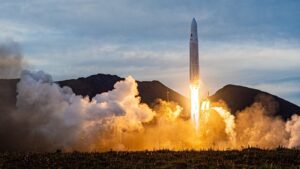Kemp’s advice to launch providers: “Listen to customers, don’t listen to pundits and market analysts,” he said.
Space industry analysts for years have warned that the market cannot support the glut of companies currently developing small launch vehicles and that only a handful will survive.
Kemp and other industry CEOs who spoke on Wednesday at the MilSat Symposium said the problem today is not a lack of demand but a shortage of operational vehicles as many small launchers are still in development.
“I think the demand for launches is incredibly high,” he said. Mega constellations are being planned and there is a diverse base of startups that are all building companies, all of which need rockets to get to orbit, Kemp added. “It seems like every week there’s a new opportunity to put an asset in space.”
Josh Brost, vice president of small rocket startup Relativity Space, agreed. “The market is sending a very clear signal that there’s this huge demand coming,” he said. The problem right now is that there is “clearly an undersupply of operational launchers,” said Brost.
Astra and Relativity expect to start launching customer payloads over the coming year.
Launch providers with operational vehicles will have plenty of business, Brost said. “There is certainly the question of how many of these announced companies turn into operational companies.”
“I’d even say that the number of companies is probably still too small for what we’re seeing from the market demand side,” Brost said. “It’s just a question of when does the supply finally catch up.”
Rocket Lab founder and CEO Peter Beck partially agreed with that take but warned that the demand is veering from small rockets toward larger vehicles that can launch bigger payloads.
“We see demand growing but I would also say that the demand has changed over the last three years since we’ve been operational,” Beck said. Rocket Lab operates the Electron small rocket and recently announced plans to develop a larger Neutron vehicle to compete with SpaceX’s Falcon 9.
“The next scale of launch vehicles is very much medium to large class to service the market requirements,” Beck said.
Offering a contrarian view was Mark Peller, vice president of United Launch Alliance, whose rockets are focused on the national security launch market.
“Our perspective on the market may be a little more tempered in comparison to the other panelists,” Peller said.
He said ULA sees a healthy demand over the next five to seven years across commercial, civil and national security launch but expressed skepticism about mega constellations and noted that some of the global demand will not be addressable by U.S. providers. “There’s still uncertainty whether all of these new constellations will become operational,” he said.
Peller also questioned the ability of small launchers to compete with big rocket rideshares. “We see the heavy lift vehicle as being extremely efficient way in terms of dollars per pound to get things to orbit.”
Competitive pressures
Kemp said Astra is preparing to ramp up production and plans to make rockets for $1 million per vehicle. To keep prices low it will use lean crews and minimum infrastructure.
“We’ll have no mission control,” he said. “That means that five people can show up with four shipping containers with no infrastructure in the field.” Astra won’t require spaceports, for example. “Just a fence with a concrete pad, and we bring all the assets to launch a rocket and a payload into orbit,” Kemp said. “That’s how we can offer a launch for a few million dollars.”
Beck said Rocket Lab will push reusability to make Neutron competitive. He lamented that Electron could not be made reusable from day one. The experience making Electron partially reusable will help with the development of Neutron, he said. “Anybody developing a launch vehicle that’s not reusable is making a dead end product. I think usability is absolutely fundamental.”



